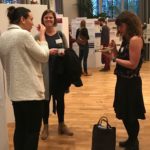
Better understanding of cells promises better cures
Cells are the focus for many of the projects within SSF’s programme for systems biology that share a total of SEK 300 million over the period 2017-2022. A common thread running through all the projects is the desire to find universally useful systems for analysing complex conditions.
Most of the projects aim to map and better understand the mechanisms within cells in a broad sense. Human cells are of particular interest, as the research could eventually lead to cures for, or at least slow down the progress of, diseases such as Parkinson’s, MS and cancer.
Plants are of course also affected by diseases, one of the projects is concentrating on crops. Åsa Strand from Umeå Plant Science Centre explained that in a changing climate with flooding and droughts, plants become more susceptible to pathogens, such as fungi. This threatens to lead to poorer crop yields in agriculture and forestry.
– Major agricultural areas, for instance in France and Spain, are becoming less productive. Therefore we need to find ways of making plants more stress tolerant, she said.
The SSF project aims to build detailed knowledge of plant mechanisms, and to understand how plant functions can be preserved regardless of stress.
Ernest Arenas from KI talked about how it might become possible to treat neurodegenerative diseases, such as Parkinson’s, by replacing lost cells with cells reprogrammed from stem cells injected into a patient’s brain. This requires detailed knowledge of the regulating mechanisms that normally specify dopamine neurons.
A project developing a method for studying the migration, or spreading, of cancer cells, using systems microscopy together with bioinformatics and statistics, is coordinated by Staffan Strömblad, also from KI. The scientists are building a model based on different variables, such as the dynamics of membranes, positioning of proteins, signalling, etc. By knowing in detail how the cancer cells move, new potential targets for cancer therapy can be identified.
Acute myeloid leukaemia (AML) is the most common form of adult leukaemia, which unfortunately has a low survival rate. Explaining that standardised treatment methods are used for many patients, Janne Lehtiö, from KI, went on to say that the introduction of new drugs is slow, and that when these finally do become available, they are extremely expensive. Many clinical trials are unsuccessful because they have failed to sufficiently identify the cancer’s subtypes, resulting in the wrong patient group being tested.
-This is such a shame as there are potential drugs that could be of great benefit to other groups. It limits our ability to match drugs and patients effectively, Janne Lehtiö said.
The project focuses on tests made on live cancer cells from patients in order to make better predictions regarding which drug is best for a certain patient, and/or to develop biomarkers for wider application.
Glioblastoma is another severe illness. A form of brain cancer, it kills most of those affected within a year. Sven Nelander’s research group at Uppsala University is combining mathematical and experimental methods to analyse how tumour growth and the response to drug molecules vary between different patients. The scientists are tracing fluorescence induced cells in mice and zebrafish models.
Female sufferers of multiple sclerosis (MS) often recover considerably during pregnancy. Mika Gustafsson, from Linköping University, talked about how physicists and physicians are collaborating to find whether hormone treatment with synthetic progesterone could help MS patients, including male ones.
– There are many different types of nerve cells, and each individual nerve cell is estimated to be connected to around 1,000 other nerve cells. Mapping the brain’s nerve cells and their connections is an enormous challenge, but it is necessary in order for us to begin to understand how the brain functions, and what will lead to psychiatric and neurological diseases, said Jonas Frisén from KI.
In his project, new technological advances are used to map nerve cells and their connections in a much quicker and more efficient manner than previously possible.
Ylva Ivarsson, Uppsala University, is studying how viruses are ”kidnapping” human cells. The viruses imitate short amino acid chains that are vital for taking over control of the host’s molecular communication (cell signalling) system and for reprogramming the cell to produce more virus particles. The SSF project is investigating cell interactions in detail in order to identify those that could be interesting for use as targets for new drugs.
Mingle around poster session.
